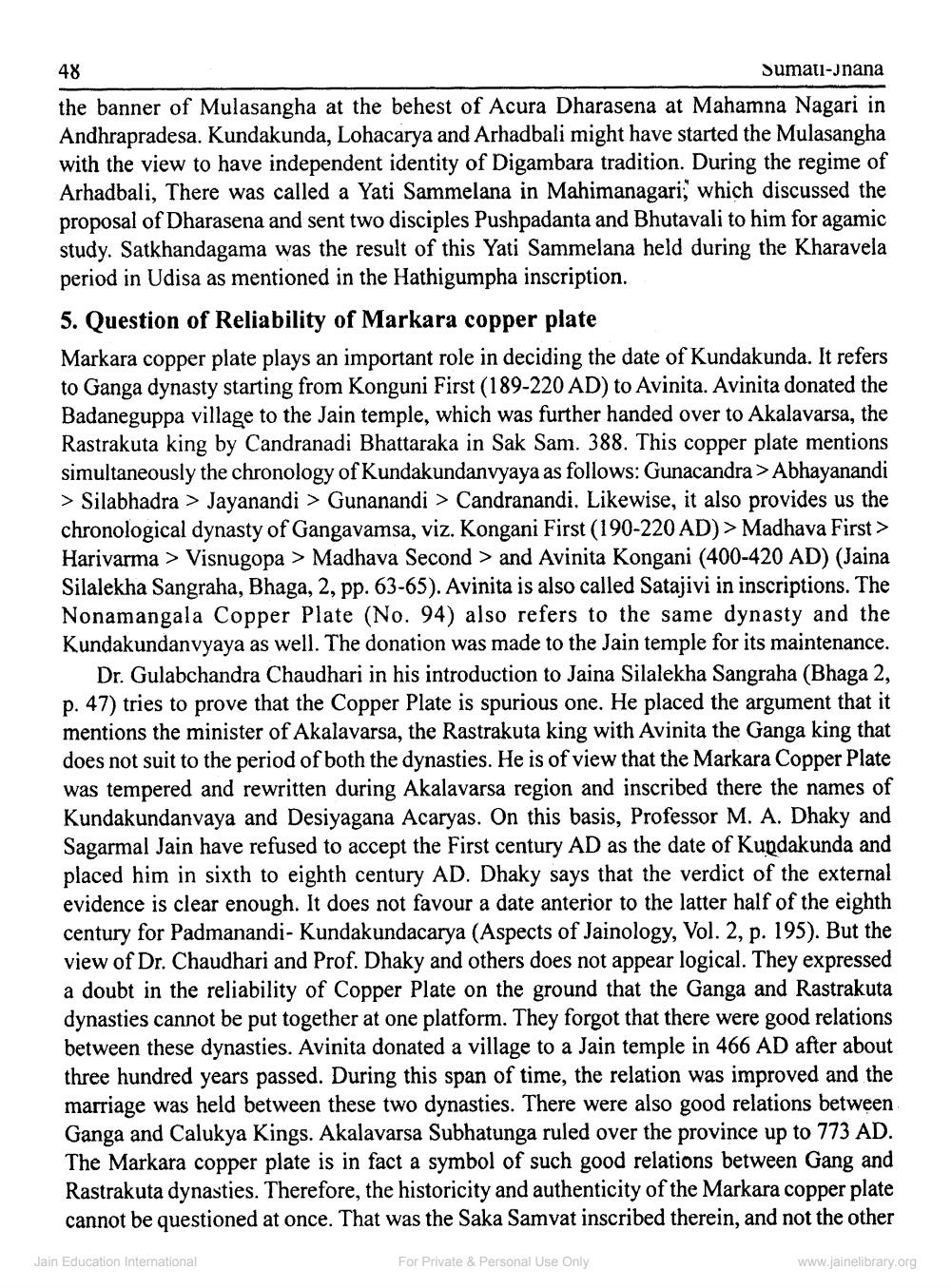________________
48
Sumati-Jnana the banner of Mulasangha at the behest of Acura Dharasena at Mahamna Nagari in Andhrapradesa. Kundakunda, Lohacarya and Arhadbali might have started the Mulasangha with the view to have independent identity of Digambara tradition. During the regime of Arhadbali, There was called a Yati Sammelana in Mahimanagari; which discussed the proposal of Dharasena and sent two disciples Pushpadanta and Bhutavali to him for agamic study. Satkhandagama was the result of this Yati Sammelana held during the Kharavela period in Udisa as mentioned in the Hathigumpha inscription.
5. Question of Reliability of Markara copper plate Markara copper plate plays an important role in deciding the date of Kundakunda. It refers to Ganga dynasty starting from Konguni First (189-220 AD) to Avinita. Avinita donated the Badaneguppa village to the Jain temple, which was further handed over to Akalavarsa, the Rastrakuta king by Candranadi Bhattaraka in Sak Sam. 388. This copper plate mentions simultaneously the chronology of Kundakundanvyaya as follows: Gunacandra > Abhayanandi > Silabhadra > Jayanandi > Gunanandi > Candranandi. Likewise, it also provides us the chronological dynasty of Gangavamsa, viz. Kongani First (190-220 AD) > Madhava First > Harivarma > Visnugopa > Madhava Second > and Avinita Kongani (400-420 AD) (Jaina Silalekha Sangraha, Bhaga, 2, pp. 63-65). Avinita is also called Satajivi in inscriptions. The Nonamangala Copper Plate (No. 94) also refers to the same dynasty and th Kundakundanvyaya as well. The donation was made to the Jain temple for its maintenance.
Dr. Gulabchandra Chaudhari in his introduction to Jaina Silalekha Sangraha (Bhaga 2, p. 47) tries to prove that the Copper Plate is spurious one. He placed the argument that it mentions the minister of Akalavarsa, the Rastrakuta king with Avinita the Ganga king that does not suit to the period of both the dynasties. He is of view that the Markara Copper Plate was tempered and rewritten during Akalavarsa region and inscribed there the names of Kundakundanvaya and Desiyagana Acaryas. On this basis, Professor M. A. Dhaky and Sagarmal Jain have refused to accept the First century AD as the date of Kundakunda and placed him in sixth to eighth century AD. Dhaky says that the verdict of the external evidence is clear enough. It does not favour a date anterior to the latter half of the eighth century for Padmanandi- Kundakundacarya (Aspects of Jainology, Vol. 2, p. 195). But the view of Dr. Chaudhari and Prof. Dhaky and others does not appear logical. They expressed a doubt in the reliability of Copper Plate on the ground that the Ganga and Rastrakuta dynasties cannot be put together at one platform. They forgot that there were good relations between these dynasties. Avinita donated a village to a Jain temple in 466 AD after about three hundred years passed. During this span of time, the relation was improved and the marriage was held between these two dynasties. There were also good relations between Ganga and Calukya Kings. Akalavarsa Subhatunga ruled over the province up to 773 AD. The Markara copper plate is in fact a symbol of such good relations between Gang and Rastrakuta dynasties. Therefore, the historicity and authenticity of the Markara copper plate cannot be questioned at once. That was the Saka Samvat inscribed therein, and not the other
Jain Education International
For Private & Personal Use Only
www.jainelibrary.org




